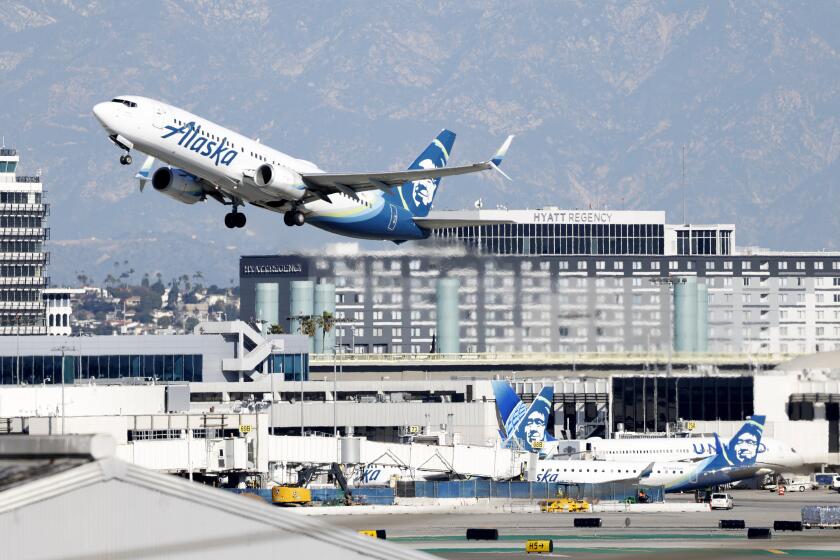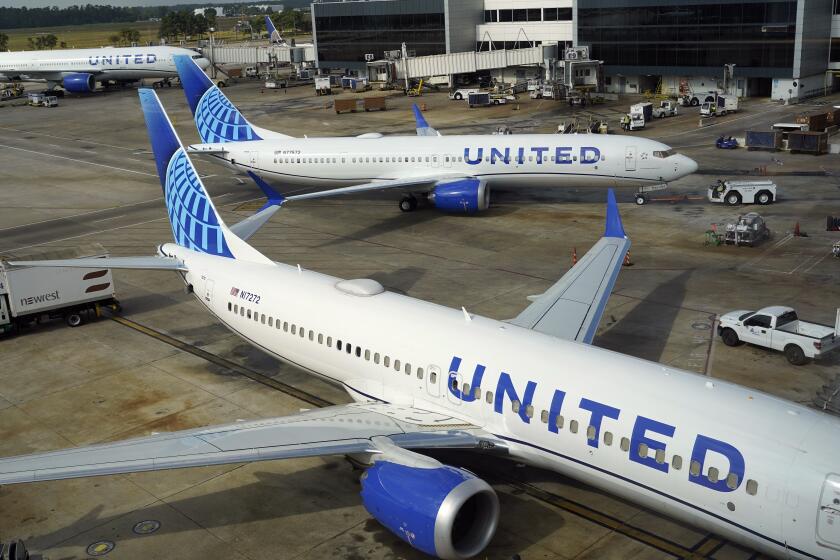‘I would absolutely not fly a Max airplane’: Ex-Boeing manager raises alarm on jets returning to service

- Share via
Last weekend Alaska Airlines and United Airlines resumed flying some of their Boeing Max 9 planes, all of which were grounded after a door panel on a Max 9 blew out in midair Jan. 5.
Although airlines, regulators and Boeing maintain that the planes are safe after a federally approved inspection and maintenance process, critics argue that serious questions remain about the long-troubled Maxes. The Max 8 had two crashes in 2018 and 2019 that killed 346 people.
“I would absolutely not fly a Max airplane,” said Ed Pierson, a former Boeing senior manager. “I’ve worked in the factory where they were built, and I saw the pressure employees were under to rush the planes out the door. I tried to get them to shut down before the first crash.”
“I would tell my family to avoid the Max. I would tell everyone, really,” said Joe Jacobsen, a former engineer at Boeing and the Federal Aviation Administration.
Aviation safety experts have pointed to the blowout as just the latest example of a deeper problem at the manufacturer. They say the company needs a cultural change.
Pierson said that returning the Max 9 to service was “another example of poor decision making, and it risks the public safety.”
Boeing said it had no comment on Pierson’s remarks.
The FAA is greenlighting an inspection and maintenance procedure for Boeing 737 Max 9 aircraft that could allow them to fly again by this weekend.
Last week, Federal Aviation Administration officials announced that Max 9 planes would be allowed to fly again, once the 171 grounded aircraft had undergone specified inspections and repairs. Most of those planes belong to Alaska Airlines and United Airlines.
Jacobsen, the former FAA engineer, said that allowing the planes to fly again was “premature,” noting that he and other safety advocates have been sounding the alarm about numerous safety problems on both the Max 8 and Max 9 for years.
“Instead of fixing one problem at a time and then waiting for the next one, fix all of them,” Jacobsen said. He compared it to playing whack-a-mole, waiting for the next problem to pop up: “Maybe it’s a week. Maybe it’s a month.”
Last year, the Seattle Times reported that Maxes have a serious defect in the engine anti-ice system. The FAA has warned that pilots must limit the use of the flawed system to five minutes, or else debris could break off that “could result in loss of control of the airplane.” Boeing was seeking an engineering exemption from the FAA for the anti-ice system on its Max 7, but withdrew it Monday, Reuters reported.
“Our long-term focus is on improving our quality so that we can regain the confidence of our customers, our regulator and the flying public,” Stan Deal, Boeing Commercial Airplanes’ chief executive, wrote in a message to employees Friday evening. “Frankly, we have disappointed and let them down.”
“Each of our 737-9 MAX [planes] will return to service only after the rigorous inspections are completed and each plane is deemed airworthy according to FAA requirements,” Alaska said in a statement.
The airline said half of its inspections were completed by the end of Monday, and the full Max 9 fleet is expected to be flying again by the end of the week. Its first Max 9 departed Friday from Seattle, landing about an hour late in San Diego that night.
After a door plug on a 737 Max 9 blew open mid-flight, CEO Dave Calhoun told Boeing employees there would be ‘100% transparency’ around ‘our mistake.’
United’s first Max 9 flight took off Saturday morning from Newark, N.J., to Las Vegas.
“As we always do, we’ll continue to work closely with Boeing and the FAA to make sure our entire fleet is reliable and, above all, safe. With that in mind, we are sending inspectors to the Boeing facility in Renton, Wash., to provide input on Boeing’s processes,” United Chief Executive Scott Kirby said in a statement.
“Let me be clear: This won’t be back to business as usual for Boeing,” FAA Administrator Mike Whitaker said in a statement last week.
“The quality assurance issues we have seen are unacceptable,” Whitaker said. “That is why we will have more boots on the ground closely scrutinizing and monitoring production and manufacturing activities.”
The FAA also noted that it would not allow Boeing to expand production of its Max fleet, including the 737 Max 9.
The National Transportation Safety Board’s investigation into the Flight 1282 midair cabin panel blowout is ongoing.
Boeing has promised to cooperate with the investigation. After the incident, Chief Executive David Calhoun acknowledged that “a quality escape” had occurred, telling employees, “This event can never happen again.”
“This blowout — we’ve seen this pattern before. Something big happens, and Boeing makes all of these promises,” said Pierson, executive director of the Foundation for Aviation Safety, a watchdog group.
The safety problems on the Boeing Max planes go far beyond this one incident, Pierson said. In September, the group published a study that found airlines filed more than 1,300 reports about serious safety problems on Max 8 and Max 9 planes to the FAA.
“These same issues that were there in 2018 and 2019 [at Boeing] that were the precursors to the accidents are still there,” Pierson said. “This is a culture where money is everything. They measure success by how many airplanes are delivered, instead of how many quality airplanes are delivered. … When you factor all of this together, it’s just a disaster waiting to happen.”
Alaska and United airlines have found problems with door plugs on their Boeing 737 Max 9 jets after the blowout of the same piece of fuselage on an Alaska flight.
Jacobsen agreed that Boeing had a cultural problem, saying the company has been “trying to maximize profits” and “go with the lowest bidder.”
“For the last 20 years, they’ve gone in this continual direction of towards financial engineering instead of technical engineering,” Jacobsen said.
Robert A. Clifford, an attorney representing families of the victims of the Max 8 crash in Ethiopia in 2019 that killed 157 people, criticized the FAA for allowing the Max 9 to resume flying.
“While we applaud the FAA for saying it will halt any Boeing 737 Max production expansion, it should not be rewarding the company by clearing Max 9 inspection instructions, paving the way for the planes to be ungrounded, until Congress and the regulators hold immediate hearings,” Clifford said. (A spokesperson for Boeing said the company had no comment.)
The FAA did not respond to a request for comment on Pierson’s and Clifford’s remarks.
Both United and Alaska had reported finding loose bolts on Max 9 planes during in-house inspections in the weeks after the Jan. 5 flight.
Pierson said that far greater action is needed on the Boeing Max, beyond door panel inspections.
“Imagine you had a new car that had a couple parts fall off of it, and the manufacturer went to go look at it and they found a couple other parts fell off. They go and fix it, but would you think there’s a possibility that something else would’ve been done improperly on that car?” Pierson said. “Now magnify that by 100.”
More to Read
Sign up for Essential California
The most important California stories and recommendations in your inbox every morning.
You may occasionally receive promotional content from the Los Angeles Times.
















